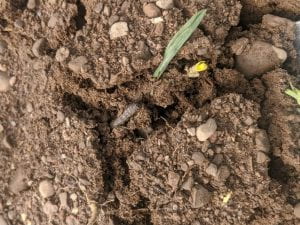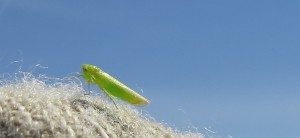June 1, 2o21
Volume 20, Number 3
Contents
View from the Field
Black Cutworm: TIME TO CHECK FIELDS!
There have been large pheromone trap captures, and these moths will potentially lay eggs in cornfields. Black cutworm migrations on weather fronts have increased the last week with some very high moth captures in western and northern NY. There have also been some fields over threshold for black cutworm in western New York. Therefore, it is a good time to start scouting for black cutworm! Check out the black cutworm degree-day model below and see what stage of larvae development is occurring in your part of the state.
Black Cutworm and Damage to Corn
Potato Leafhopper Is Here!
I found potato leafhopper in alfalfa in Dutchess County this week. They were at very low numbers but an indication that they might have come in on the last storm front.
Cereal Leaf Beetle
There have been a few reports of finding cereal leaf beetle larvae in winter wheat. These are at low levels currently. Generally, cereal leaf beetle can cause more injury to oats but at times can be at numbers that can damage other spring small grains. Rarely, does it cause an issue in winter small grains.
Alfalfa Weevil
There are reports of alfalfa weevil being over threshold in western NY. Normally the first cutting of alfalfa will control alfalfa weevil with some exceptions. Check the degree-day model below to see what stage of development alfalfa weevil is at near your farm.
Fusarium Head Blight Update- May 28th
Dr. Gary Bergstrom-Extension Plant Pathologist-Professor
Much of the winter wheat in New York will begin flowering (emergence of yellow anthers on heads) over the next week. The DMI (FRAC Group 3) containing fungicides Caramba, Prosaro, or Miravis Ace (latter includes a FRAC Group 7 fungicide) are the most effective fungicides for suppression of FHB and DON contamination when applied at flowering. A flowering application of these fungicide products should be based on Fusarium head blight (FHB) risk as well as the risks of powdery mildew, rusts, and fungal leaf blotches in the upper canopy based on scouting of individual fields. There is an application window of approximately 7 days from the beginning of flowering in which reasonable FHB and DON suppression can be expected. Severe powdery mildew has been observed in some mildew-susceptible varieties. Risk of FHB infection has remained low primarily because of low temperatures which could change over the next several days. Check the Fusarium Risk Assessment Tool (www.wheatscab.psu.edu) and your local weather forecast frequently as your winter wheat crop approaches heading and flowering.
Winter malting barley is generally beyond growth stages at which a foliar fungicide application should be considered.
Black Cutworm Degree-Days by Location of Intense Catches
*Intense Catch is over 15 moths in a week.
True Armyworm Degree-Days by Location of Intense Catches
*Intense Catch is over 15 moths in a week.
Black Cutworm Moth Catches in New York
True Armyworm Moth Catches in New York
NYS IPM Field Corn Pheromone Trapping Data
Clipboard Checklist
Keith Waldron, NYS IPM
General
*Walk fields to check tile flow, check and clear drainage outlets. Look for line breaks
*Note and record location of wet areas on field maps or aerial photo for future tiling considerations and crop decisions, check for areas of soil erosion
*Pre-plant weed evaluation, timing cultivation and/or pre-plant weed management
*Watch for early season weeds: winter annuals, chickweed, henbit, field penny cress, shepherd’s purse, giant and common ragweed, purple deadnettle, lambsquarters, redroot pigweed, velvet leaf, Pennsylvania smartweed, common sunflower, quackgrass, foxtail
Alfalfa:
*Evaluate established legume stands for winter damage (thinning stand, frost heave, Brown root rot), determine average alfalfa stand count adjust crop plans if necessary
*Monitor for alfalfa weevil, crown or foliar diseases
*Monitor new seedings for Pythium blight and Phytopthora Root Rot.
*Monitor for Alfalfa Snout Beetle (In Oswego, Jefferson, Cayuga, Wayne, Lewis, St. Lawrence, Clinton, Essex, and Franklin counties)
Small Grains:
*Monitor winter grain fields for over wintering survival (snow mold and other cold injury issues), weed issues (such, as winter annuals, corn chamomile and chickweed), growth stage, number of tillers, foliar diseases (powdery mildew, rusts)
*Check stands for soilborne virus diseases, Wheat spindle streak mosaic and Soilborne wheat mosaic, check for signs of powdery mildew or other maladies, cereal leaf beetle, weed escapes, goose damage
Corn:
*Prepare land and plant corn as conditions allow
*Pre-plant weed evaluation, timing cultivation and/or pre-plant weed management
*Emergence: assess stand, population count
Soybeans:
*Prepare land and plant soybeans as conditions allow
*Pre-plant weed evaluation, timing cultivation and/or pre-plant weed management
Pastures:
*Check and mend fences as needed.
*Check crop growth
*Monitor fields for invasive species, plants harmful to livestock
*Review/Plan rotation system
Equipment:
*Remove / clean soil and crop debris from equipment
*Arrange for custom weed control or check your own application or cultivator equipment for repairs.
*Carry appropriate / necessary NYS DEC and EPA required documents: (pesticide applicators license, pesticide labels, MSDS sheets, etc.) with application equipment
*Calibrate:
-planting equipment – maintain records on planting rate per field
-manure spreaders – maintain records on amount spread per field
-pesticide application equipment – Check nozzles, pumps, etc., recalibrate pesticide application equipment before use.
Storage:
* Check stored grain bins for temperature, moisture and signs of mold and insects. Aerate, core, transfer grain or treat as necessary
*Check forage allocation and anticipate feed program adjustments as forages from previous year are used up
*Plan where forages should be stored for optimum allocation next feeding season










